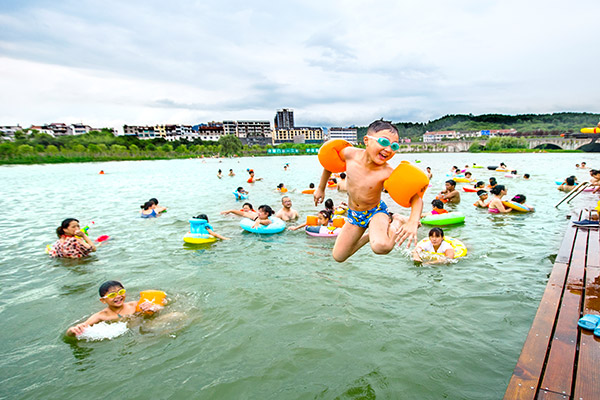
Local children swim and play in Cuihu Lake in Pujiang county, the target of Zhejiang province's "Water Movement" launched in June 2013. (Photo/China Daily)
Crackdown on pollution puts sparkle back into Pujiang's local economy
Zhou Chengle, 62, relaxes outside his whitewashed three-story home in Jinhua, East China's Zhejiang province, and watches the local children paddling in the shallows of a sun-drenched Cuihu Lake.
Just four years ago, if he had seen someone swimming in the lake, the local landlord probably would have called for an ambulance.
"Before 2013, Cuihu Lake had all kinds of waste floating on the surface. Bad smells used to come up from the lake," he recalled.
The lake then was a sickly shade of milky-white, poisoned by tons of untreated waste dumped into it by 1,400 crystal glass workshops huddled around its banks.
Cuihu's transformation from cesspit to picturesque bathing spot was the result of a huge anti-pollution campaign launched by Zhejiang province in 2013, an initiative that has had far-reaching effects on not only the region's waterways but its economy and society.
Black crystal
Cuihu and its surrounding area, Pujiang county, was the first place targeted by Zhejiang's "Water Movement" launched in June 2013.
In Pujiang, 22,000 local companies churned out 85 percent of the world's hot fix crystal glassware.
The crystal industry had brought huge wealth to the county, with Pujiang's urban residents' per capita annual disposable income trebling from 9,542 yuan ($1,392) in 2003 to 30,711 yuan a decade later. Zhou had benefitted from the industry himself, renting out his downstairs flat to be used as a crystal workshop.
But cutthroat competition and lax regulation in the industry had also unleashed devastating pollution. By 2013, Pujiang was the most polluted county in China, according to China Global Television Network. More than 500 of its water sources were milk-white like Cuihu, while another 25 had turned black.
The county government had attempted to crack down on polluters in 2006 and 2011, but quickly aborted both campaigns for fear of damaging the industry, which then accounted for over 11 percent of the county's GDP and provided employment to more than 200,000 people.
With fear spreading that Pujiang's toxic waterways could create a public health emergency in the county and downstream Hangzhou, home to 9 million people, Zhejiang decided to take radical action to clean up China's "crystal capital".


















































